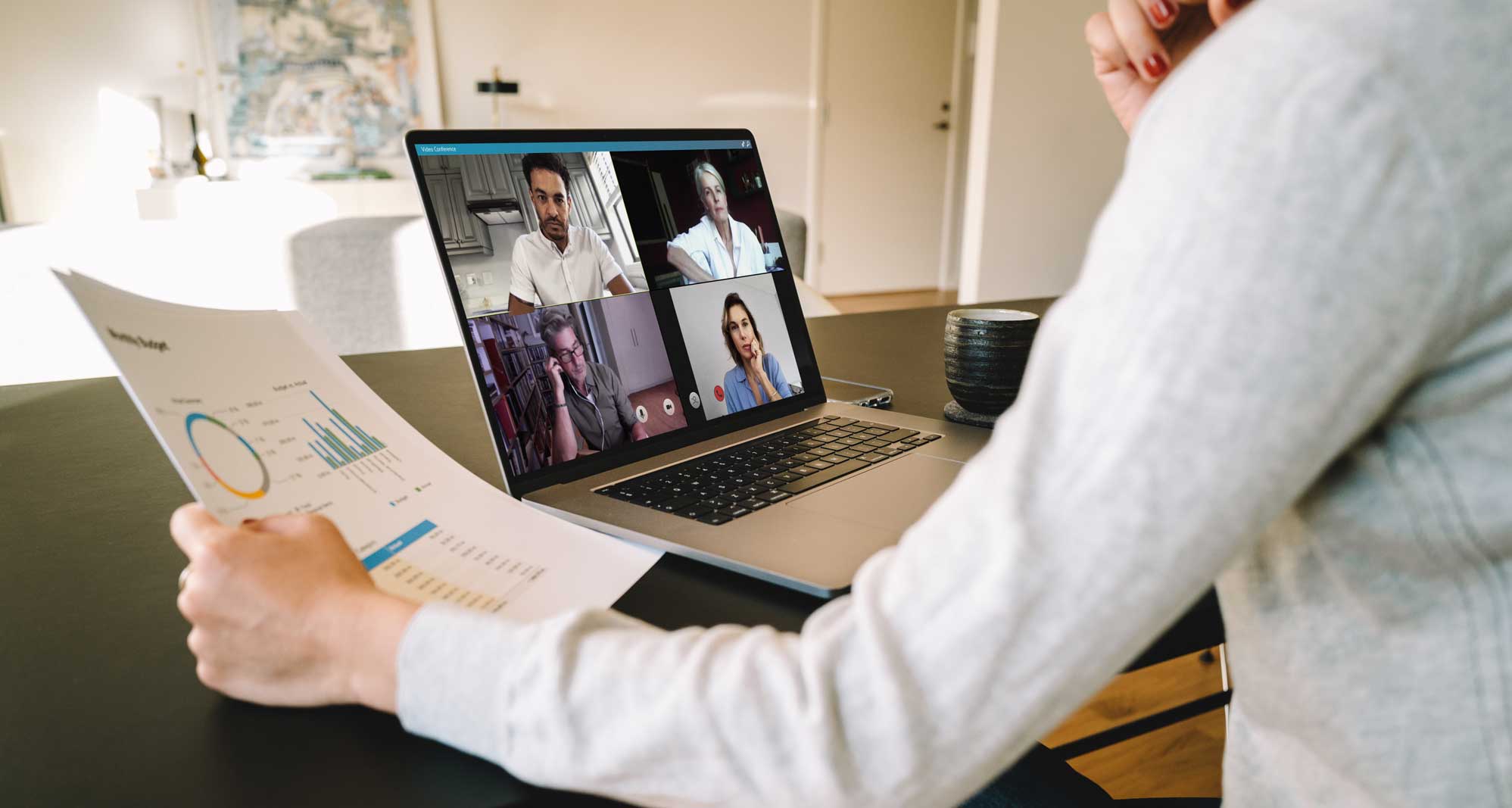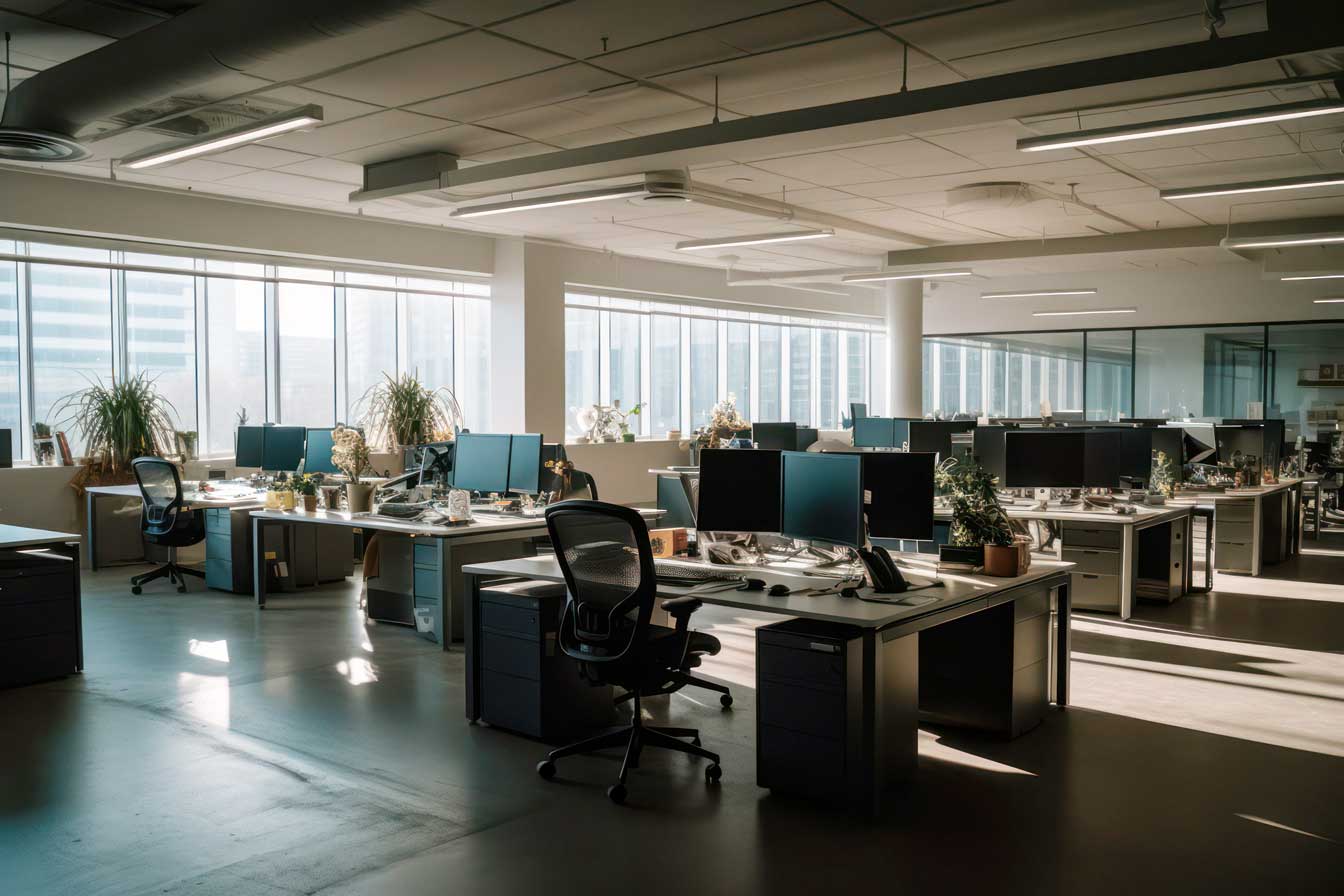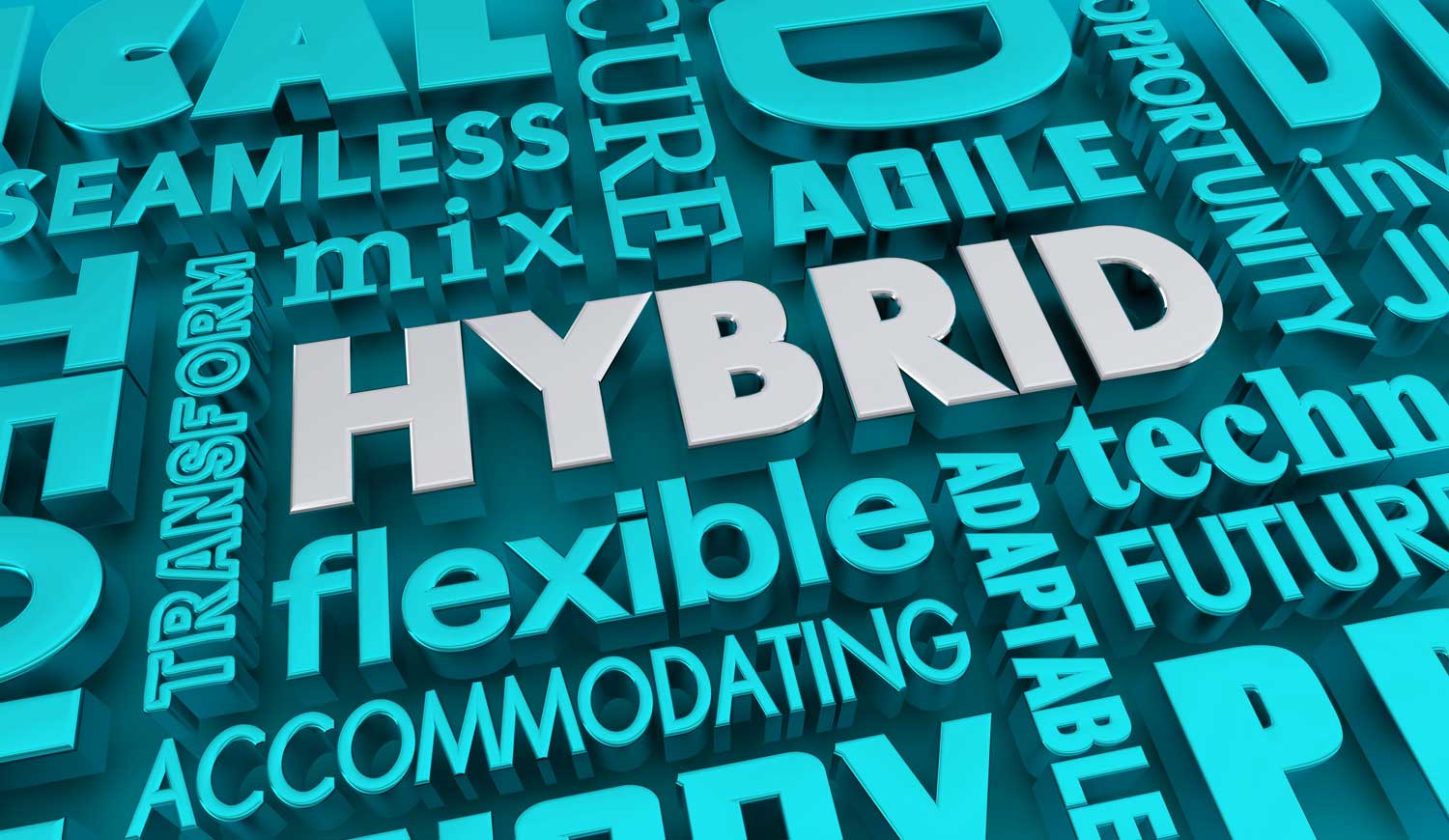The world of work is changing faster than ever, with flexible and hybrid arrangements quickly becoming the norm for many employees. In fact, a recent Australian study reveals that 67% of workers now see these flexible arrangements as the standard way of working (Gensler, 2020). This shift presents exciting opportunities for companies to create workspaces that cater to a variety of work styles, promote employee well-being, and encourage both collaboration and focus.
In this post, we explore the ins and outs of designing successful flexible and hybrid workspaces that not only accommodate remote and in-person work but also assist with making the transition to this new work model as smooth as possible. We delve into the crucial role of architects and designers in crafting spaces that address the diverse needs of today’s workforce and discuss how thoughtful integration of design principles can lead to work environments that boost productivity, collaboration, and well-being.
Join us as we dive into the fascinating world of flexible, hybrid and activity based workspaces and discover the key design principles that can help organizations navigate the challenges of transitioning to this new way of working.
Defining Flexible and Hybrid Workspaces
Before exploring the background of flexible and hybrid workspaces, it is essential to understand the difference between these two terms, as they are often used interchangeably but have distinct meanings.
Flexible Workspaces
Flexible workspaces are designed to accommodate a wide range of work styles and needs by providing various types of workstations, such as individual desks, collaborative areas, and informal meeting spaces. These workspaces are typically adaptable and can be reconfigured to meet changing needs, making them suitable for diverse teams and tasks.
Flexible workspaces may also provide shared resources and amenities, such as meeting rooms, kitchens, and break-out areas, encouraging collaboration and communication among employees.
Hybrid Workspaces
Hybrid workspaces refer to work environments that support a combination of remote and in-person work (Gensler, 2020). The hybrid workspace model acknowledges that employees may work from different locations, such as home, co-working spaces, or the office, and it aims to create an inclusive and seamless experience for all team members, regardless of their physical location.
Hybrid workspaces often incorporate technology solutions that enable remote collaboration and communication, as well as adaptable physical spaces that can be used by employees when they are in the office (Gensler, 2020).
While both flexible and hybrid workspaces prioritise adaptability and responsiveness to changing work styles and needs, the key distinction is that hybrid workspaces specifically focus on supporting a mix of remote and in-person work, while flexible workspaces prioritise versatility within the physical workspace itself (Knoll, 2020).
With these definitions established, we can now explore the background of flexible and hybrid workspaces and their role in modern work environments.
The Evolution of Flexible & Hybrid workspaces
Flexible and hybrid workspaces emerged in response to the modern workforce’s evolving needs and the increasing demand for adaptable work environments. The origins of hybrid working date back to the 1970s and 1980s with flexible work arrangements like telecommuting and flexitime (Nilles, 1975; Toffler, 1980). These early arrangements set the stage for more versatile work models.
Technology advancements and the internet boom in the late 1990s and early 2000s made remote work more accessible, leading to greater popularity for hybrid work models (Cascio, 2000). Organizations began combining remote and in-office work to offer employees more flexibility and autonomy (Bailey & Kurland, 2002).
Over the past two decades, hybrid work has evolved further, with coworking spaces and shared office environments offering increased flexibility and collaboration opportunities (Moriset, 2014). Companies like Australian software company Atlassian and global professional services firm PwC Australia have successfully adopted flexible and hybrid workspaces, catering to various work styles and preferences.

The COVID-19 Factor
The COVID-19 pandemic significantly accelerated the adoption of flexible working models as organizations transitioned to remote work for safety reasons. This shift showcased the viability of remote and flexible work models for many companies.
A 2020 Gartner study found that 82% of company leaders planned to allow employees to work remotely, at least part-time, even post-pandemic (Gartner, 2020). A PwC survey in 2021 revealed that 83% of employers considered the remote work shift a success, with 55% of employees preferring to work remotely at least three days a week (PwC, 2021).
Further research, such as the Society for Human Resource Management (SHRM) and the World Economic Forum (WEF), supports the effectiveness of hybrid and remote work models, highlighting benefits like improved work-life balance, reduced commuting costs, and increased productivity (SHRM and Harris Poll, 2022; WEF, 2022).
These findings show that the COVID-19 pandemic played a crucial role in driving demand for more flexible work models, as both employers and employees recognize the benefits of such arrangements.
The Role of Architecture and Interior Design in Modern Work Environments
Architecture and interior design play a crucial role in shaping the experience of modern workspaces. They are responsible for creating environments that support productivity, collaboration, and well-being, while also accommodating the needs of a diverse and dynamic workforce (Vischer, 2008).
This requires a deep understanding of human behaviour, ergonomics, and the psychological and physiological impacts of design, as well as the ability to balance aesthetic considerations with functional requirements.
The Evolution of Workplace Design
The evolution of workplace design has seen a shift from traditional office layouts to more flexible and adaptable work environments. This transformation is characterised by a progression from individual private offices and cubicles to open-plan spaces, and ultimately to the hybrid workplace model.
Throughout this evolution, architects and other design professionals have sought to balance the needs for privacy, collaboration, and adaptability to create spaces that promote productivity, well-being, and employee satisfaction.
Traditional Office Spaces
Traditional office spaces feature fixed desks, enclosed offices, and rigid spatial hierarchies (Brill et al., 2001). This model assumes that employees need dedicated, private spaces to work, and collaboration is managed through formal meetings and designated communal areas (Duffy, 1997).
The traditional office model’s hierarchy is evident in the layout, with spaces allocated based on employee rank, function, and privacy needs (Steele, 1986; Becker, 1990). This hierarchy manifests in various ways:
- Private offices: Executives and managers typically have private offices, often located along the building’s perimeter, offering natural light, views, and prestige (Becker, 1990).
- Cubicles and open workstations: Lower-ranking employees work in cubicles or open workstations in the office center (Steele, 1986), offering less privacy and access to natural light compared to private offices.
- Conference rooms and meeting spaces: Traditional office layouts have designated conference rooms and meeting spaces reserved for specific purposes or employee ranks (Becker, 1990).
- Reception and waiting areas: The reception area is the first point of contact between visitors and the company, with a waiting area for guests (Steele, 1986).
- Support spaces and amenities: Support spaces like break rooms, restrooms, and storage areas are segregated in traditional office layouts (Becker, 1990).
As the nature of work has evolved, so has the demands on the physical environment, leading to the re-evaluation of the traditional office model and the emergence of more flexible and adaptive workspace designs.

Emergence of Open-Plan Offices
In the mid-20th century, the open-plan office emerged as an alternative to the traditional office model, with the aim of fostering greater collaboration and communication among employees (Brennan et al., 2002). These spaces typically feature large, open areas with few or no physical barriers, allowing for easy interaction and collaboration among employees.
However, research has shown that open-plan offices can also have negative effects on employees’ productivity, well-being, and satisfaction, due to increased noise levels, distractions, and a lack of privacy (Kim & de Dear, 2013).
Consequently, organisations and designers have begun to explore alternative workspace models that strike a balance between the benefits of open spaces and the need for more private and focused work areas.
The Shift Towards Flexible & Hybrid Workplaces
Flexible and hybrid workspaces represent the latest evolution in workspace design, combining open, collaborative spaces with more private, focused work areas (Worthington, 2006). These adaptable spaces accommodate various work styles and functions, recognizing the diverse needs and preferences of the modern workforce (Becker & Steele, 1995), making them popular among organisations seeking more engaging, supportive, and productive work environments.
In a hybrid workplace model, different types of workspaces cater to employees’ diverse needs and work activities. Some common workspace types include:
- Private offices: Individual rooms for employees requiring high levels of privacy and concentration, often reserved for managers, executives, or those handling sensitive information.
- Huddle rooms: Small meeting rooms for quick, informal meetings, brainstorming sessions, or impromptu collaboration, typically equipped with basic audio-visual technology and comfortable seating.
- Breakout areas: Casual spaces for relaxation, informal collaboration, or socializing, featuring soft seating, coffee tables, and amenities like coffee machines or snack stations.
- Quiet zones: Designated areas for focused work, offering employees a quiet, distraction-free environment, which may include privacy booths, soundproof pods, or separated areas with noise-reducing materials.
- Collaborative spaces: Open areas for teamwork and collaboration, featuring modular furniture, whiteboards, and technology that supports group work and brainstorming sessions.
- Lounge areas: Informal spaces for relaxation and social interaction, with comfortable seating, coffee tables, and a casual atmosphere.
- Outdoor workspaces: Exterior spaces providing an alternative, natural environment for work or breaks, including seating, tables, shade structures, and access to power outlets.
- Hot-desking: A workspace arrangement where employees do not have assigned desks and can choose where to sit on a first-come, first-served basis or through a booking system that allows them to reserve specific workspaces in advance. Hot-desking promotes flexibility, efficient use of space, and encourages interaction among employees by allowing them to work in different areas and with different colleagues each day. This setup is particularly suitable for organizations with a significant portion of remote or mobile employees who do not require a permanent workspace in the office.
The specific mix of workspace types within a hybrid workplace varies depending on an organisation’s needs, culture, and work nature. By offering diverse workspace options, a hybrid workplace model caters to employees’ preferences and work styles, supporting increased productivity, collaboration, and well-being.
Key Design Principles for Flexible and Hybrid Workspaces
In order to create successful flexible and hybrid workspaces, architects and designers must consider some key design principles that address the diverse needs of a modern workforce. These principles aim to foster an environment that encourages productivity, collaboration, and well-being, while seamlessly accommodating both remote and in-person work modalities.
This section will explore design principles that guide the development of flexible and hybrid workspaces, ensuring they effectively support employees in their various tasks and activities.
Adaptability and Flexibility
One of the key principles underpinning flexible and hybrid workspaces is the need for adaptability and flexibility in both the physical environment and organisational structures (Worthington, 2006).
Adaptability and flexibility are crucial in flexible and hybrid workplaces for several reasons:
- • Catering to diverse employee needs, preferences, and workstyles.
- • Accommodating constantly evolving work dynamics, technologies, and collaboration methods.
- • Optimising space usage for maximum efficiency and cost reduction.
- • Enhancing employee well-being by providing various work settings that balance privacy and interaction.
- • Supporting business agility by enabling easy workspace reconfiguration in response to changing market conditions.
Achieving adaptability and flexibility can be done through modular and reconfigurable furniture and by creating multi-purpose spaces that can be easily transformed for different tasks and functions.

-
Modular and reconfigurable furniture
-
Modular and reconfigurable furniture allows organisations to adapt their workspaces to employees’ and business needs, enhancing engagement, well-being, and productivity (Clements-Croome, 2018). Examples include:
-
• Movable walls: Easily repositioned or removed to create open or closed spaces as needed.
-
• Adjustable desks: Height-adjustable desks promote ergonomic comfort and reduce sedentary-related health risks.
-
• Flexible seating options: Various seating options like lounge chairs, bean bags, and ergonomic office chairs support comfort and collaboration.
-
Multi-Purpose spaces for adaptable work environments
-
Multi-purpose spaces support diverse work styles and activities, promoting flexibility and autonomy (O’Neill, 2010). Examples and uses include:
-
• Breakout areas: Informal meeting spots or relaxation zones, encouraging spontaneous collaboration and idea-sharing.
-
• Lounge spaces: Alternative settings for individual work or informal meetings, fostering creativity and innovation.
-
• Meeting rooms: Adjustable furniture, lighting, and technology make these rooms adaptable for various purposes and team sizes.
-
• Huddle spaces: Small, informal spaces designed for impromptu team discussions or quick problem-solving sessions.
Balancing Privacy and Collaboration in Flexible and Hybrid Workspaces
Designing hybrid workspaces requires balancing collaboration and privacy for focused work. Key factors to consider include:
- Spatial separation: Use partitions, screens, and plants to create visual and acoustic barriers between work zones.
- Acoustic considerations: Use sound-absorbing materials and sound masking technologies to minimize noise distractions.
- Enclosed spaces: Offer enclosed spaces like booths, focus rooms, and private offices for quiet and private work.
- Activity-based zoning: Separate collaborative and quiet areas by designing workspaces based on activity zones.
- Flexible furniture: Incorporate adjustable desks and movable screens for a personalized and comfortable workspace.
Thoughtful design addresses privacy concerns while fostering collaboration, contributing to a successful and productive workplace.
Biophilic Design for Well-being and Productivity
Biophilic design connects people with nature in the built environment, boosting well-being and productivity. Integrating elements like greenery, natural light, and organic materials creates restorative and engaging workspaces that support employee well-being and performance.
-
The impact of nature on well-being and productivity
-
Research has shown that exposure to natural elements can have a range of positive effects on human well-being including reduced stress, improved cognitive function, and increased satisfaction (Browning et al., 2014; Kaplan, 1993).
-
Incorporating biophilic design in hybrid workspaces offers numerous benefits:
-
• Increased productivity due to improved concentration and cognitive function
-
• Reduced absenteeism and presenteeism, lowering related costs
-
• Improved mental health, leading to a more resilient workforce
-
• Enhanced employee satisfaction and engagement
-
• Attraction and retention of top talent
-
• Stimulated creativity and innovation, benefiting the organisation overall
-
Integrating natural elements into the workspace
-
There are several ways in which natural elements can be integrated into the workspace, including:
-
• Adding greenery: Including plants or green walls to create a connection with nature.
-
• Using natural materials: Employing materials like wood or stone in design elements.
-
• Maximising natural light: Carefully placing windows and skylights to increase natural light exposure.
-
• Incorporating fractal design: Drawing inspiration from nature’s self-replicating patterns, like tree branches or snowflake geometry, to create visually appealing and harmonious environments.
-
By integrating these elements, architects and designers create more restorative and engaging workspaces that enhance employee well-being and productivity.

Technology Integration
The integration of technology into the workspace is a critical component of flexible and hybrid workspaces, supporting both remote and in-person collaboration and enabling employees to work seamlessly across different locations (Becker & Steele, 1995). To achieve this, architects seek to consider the following:
-
Supporting remote and in-person collaboration
-
Flexible and hybrid workspaces need to accommodate both remote and in-person collaboration, recognising that employees may work from different locations and require access to tools and resources that support effective communication and collaboration (Brown, 2009).
-
This can be achieved through the integration of technologies such as video conferencing systems, file-sharing platforms, and collaborative software tools that enable employees to work seamlessly across different locations and devices.
-
Smart building technologies and IoT
-
Smart building technologies and IoT devices can be integrated into the workspace to enable greater control over the environment and enhance the overall employee experience (Clements-Croome, 2018).
-
This might include the use of sensors to monitor and optimise lighting, temperature, and air quality, or the incorporation of smart furniture and appliances that can be controlled and customised by individual employees.
-
By integrating these technologies into the workspace, organisations can create more responsive and adaptive environments that support employee well-being, productivity, and satisfaction.
Design Approach for Flexible and Hybrid Workspaces
The design approach for flexible and hybrid workspaces requires a thoughtful understanding of the unique challenges and opportunities presented by this work model. Architects and designers must carefully consider various methodologies and strategies that cater to the diverse needs of the workforce while optimising the spatial layout and functionality of the workplace.
This section will discuss critical aspects of the design approach for flexible and hybrid workspaces, highlighting how informed design decisions contribute to the creation of adaptable, supportive, and efficient work environments.
Human-centered Design
Human-centered design is an approach that places the needs and preferences of the end-users at the centre of the design process, seeking to create spaces and experiences that are intuitive, engaging, and supportive (Norman & Draper, 1986). By identifying potential challenges and finding solutions that cater to diverse needs, human-centered design helps create inclusive and accommodating environments.
In the context of flexible and hybrid workspaces, architects seek to understand the needs and preferences of the workforce, addressing the challenges faced in designing such spaces, and designing environments that not only accommodate these needs but also foster a sense of inclusion and belonging.
-
Understanding user needs and preferences
-
Understanding user needs and preferences is vital for successful flexible and hybrid workspaces. Architects should consider factors such as work styles, tasks, and preferences, using methods like interviews, surveys, and observations to gain insights.
-
Designers must also understand the organisation’s culture, values, and practices, addressing challenges related to change, communication, and adaptation. Involving employees in the design process through participatory design workshops or focus groups can help identify concerns and empower employees to contribute to the workspace.
-
A user-centered approach that acknowledges workplace culture impacts can create tailored flexible and hybrid workspaces, addressing challenges and contributing to the model’s success and sustainability within the organisation.
Empathy and Inclusivity in Design
In addition to understanding the needs and preferences of the workforce, designers must also consider the importance of empathy and inclusivity in the design process, ensuring that spaces are accessible and accommodating to all users, regardless of their background, abilities, or personal circumstances (Steinfeld & Maisel, 2012).
This might involve the incorporation of accessible design features, such as ramps and adjustable workstations, as well as the creation of spaces that support a variety of cultural and social preferences.
For instance, adjustable workstations can accommodate employees with different ergonomic needs, allowing them to work comfortably regardless of their height, physical ability, or preferred posture.
Quiet zones or designated focus areas can be designed to cater to employees who require a calm and distraction-free environment to concentrate on their tasks, while collaborative spaces can provide a suitable setting for team-based work and informal meetings.
By incorporating such design elements, designers can create an inclusive and accommodating workspace that caters to a diverse range of work styles and preferences.
Evidence-based Design: Utilising Research and Data to Inform Design Decisions
Evidence-based design is an approach that utilises research and data to inform design decisions, ensuring that spaces are not only aesthetically pleasing but also functionally effective and supportive of human well-being and performance (Ulrich et al., 2008).
In the context of flexible and hybrid workspaces, designers may conduct research on human behaviour, ergonomics, and the psychological and physiological impacts of design to create environments that support productivity, collaboration, and well-being. Incorporating research findings and analysing data collected from user feedback and post-occupancy evaluations are essential aspects of evidence-based design.
By drawing on this information, designers can make informed decisions to create successful flexible and hybrid workspaces that cater to the diverse needs of the workforce.

-
Evaluating the impact of design on performance and well-being
-
In addition to utilising research and data to inform design decisions, designers must also evaluate the impact of their designs on employee performance and well-being, ensuring that spaces are continually optimised and adapted to meet the changing needs of the workforce (Preiser et al., 2015).
-
Methods may include the use of post-occupancy evaluations, surveys, and user feedback to assess the effectiveness of the workspace and identify areas for improvement or refinement.
Sustainable Design
Sustainable design is an approach that seeks to minimise the environmental impact of the built environment, incorporating sustainable materials and practices that promote energy efficiency, resource conservation, and ecological balance (McLennan, 2004).
In relation to flexible and hybrid workspaces, this might involve the use of energy-efficient lighting and heating systems, the incorporation of sustainable materials such as reclaimed wood or recycled metal, and the integration of green spaces and natural elements that support biodiversity and ecological health.
-
Addressing environmental impact
-
Designers of flexible and hybrid workspaces must also consider the overall environmental impact of the workspace, implementing strategies to minimize resource consumption and reduce the workspace’s carbon footprint (Kibert, 2016). Incorporating elements that promote energy efficiency, resource conservation, and ecological balance is essential (McLennan, 2004).
-
This may include the use of energy-efficient lighting and heating systems, as well as the incorporation of sustainable materials such as reclaimed wood or recycled metal. Additionally, the integration of green spaces and natural elements that support biodiversity and ecological health is important.
-
Other solutions could include renewable energy sources such as solar panels and the implementation of energy management systems that monitor and optimize energy usage. Furthermore, designers should consider the use of water-saving fixtures, waste reduction strategies, and the promotion of eco-friendly commuting options for employees.
-
Indoor environmental quality
-
Indoor environmental quality (IEQ) is an important aspect of sustainable design, as it directly impacts the health, well-being, and productivity of occupants (Fisk, 2000). In the context of flexible and hybrid workspaces, designers must consider factors such as air quality, thermal comfort, lighting, and acoustics, ensuring that spaces are not only visually appealing and functionally effective but also promote occupant well-being and satisfaction.
-
This can be achieved through the use of natural ventilation systems, the incorporation of high-quality air filtration systems, and the careful selection of materials and finishes that minimise the emission of volatile organic compounds (VOCs).
The WELL Building Standard
The WELL Building Standard is a globally recognized framework that focuses on the design and construction of built environments that promote human health and well-being (WELL, 2021). This standard complements the principles of human-centered design by emphasising the importance of creating spaces that support the physical, mental, and social needs of the people who use them.
The WELL Building Standard encompasses various concepts, including air and water quality, nourishment, light, fitness, comfort, and mind, which together contribute to the creation of a holistic and healthy workspace (WELL, 2021).
By aligning workspace design with the WELL Building Standard, architects and designers can ensure that they are not only addressing the functional requirements of flexible and hybrid workspaces, but also prioritising the well-being and overall experience of the employees who occupy them.
The Final Word…
Flexible and hybrid workspaces are the future, offering engaging, supportive, and productive environments for diverse modern workforces. Successful workspaces depend on integrating design principles focused on productivity, collaboration, well-being, and accommodating various work styles.
Designers and organisations should embrace adaptability, inclusivity, and sustainability, and continuously evaluate and adapt workspaces based on feedback and research.
By fostering a culture of well-being, sustainability, and inclusivity, these workspaces shape the future of work, driving innovation and growth in a resilient, adaptable environment.
Get in touch to find out how we can help you create a flexible and hybrid workspace that supports your organisation’s needs.
References
Bailey, D. E., & Kurland, N. B. (2002). A review of telework research: findings, new directions, and lessons for the study of modern work. Journal of Organizational Behavior
Becker, F. (1990). The Total Workplace: Facilities Management and the Elastic Organisation. Van Nostrand Reinhold.
Brill, M., Weidemann, S., & BOSTI Associates. (2001). Disproving widespread myths about workplace design. Kimball International, Jasper, IN.
Browning, W. D., Ryan, C. O., & Clancy, J. O. (2014). 14 Patterns of Biophilic Design. Terrapin Bright Green LLC.
Cascio, W. F. (2000). Managing a virtual workplace. The Academy of Management Executive, 14(3), 81-90.
Duffy, F. (1997). The new office. Conran Octopus.
Fisk, W.J. (2000). Health and productivity gains from better indoor environments and their relationship with building energy efficiency. Annual Review of Energy and the Environment, 25(1), 537-566.
Gensler. (2020). Gensler US Workplace Survey 2020: Work From Home. Gensler Research Institute.
Gensler. (2020). Designing for the Future of Work: The Hybrid Office. Retrieved from https://www.gensler.com/research-insight/blog/designing-for-the-future-of-work-the-hybrid-office
JLL. (2020). The Future of Global Office Demand. Retrieved from https://www.us.jll.com/en/trends-and-insights/research/future-of-global-office-demand
Kellert, S. R. (2018). Nature by Design: The Practice of Biophilic Design. Yale University Press.
Kibert, C. J. (2016). Sustainable Construction: Green Building Design and Delivery. John Wiley & Sons.
Kim, J., & de Dear, R. (2013). Workspace satisfaction: The privacy-communication trade-off in open-plan offices. Journal of Environmental Psychology, 36, 18-29.
Knoll. (2020). The Distributed Work Landscape. Retrieved from https://www.knoll.com/knollnewsdetail/the-distributed-work-landscape
Lippman, P. C. (2015). Can the physical environment have an impact on the learning environment? OECD Education Working Papers, No. 118, OECD Publishing, Paris.
Moriset, B. (2014). Building new places of the creative economy. The rise of coworking spaces. In 2nd Geography of Innovation International Conference (pp. 23-25).
Nilles, J. M. (1975). Telecommunications and Organisational Decentralization. IEEE Transactions on Communications, 23(10), 1142-1147.
Sanders, E. B. N., & Stappers, P. J. (2008). Co-creation and the new landscapes of design. CoDesign, 4(1), 5-18.
SHRM and Harris Poll. (2022). Remote Work Productivity Study. Society for Human Resource Management. Retrieved from https://www.shrm.org/hr-today/trends-and-forecasting/research-and-surveys/Documents/Remote_Work_Productivity_Study.pdf
Steele, F. (1986). Making and managing high-quality workplaces: an organizational ecology. Teachers College Press.
van der Voordt, T. (2004). Productivity and employee satisfaction in flexible workplaces. *Journal of Corporate Real Estate, 6(2), 133-148.
Vischer, J. C. (2008). Towards an environmental psychology of workspace: How people are affected by environments for work. Architectural Science Review, 51(2), 97-108.
WELL. (2021). WELL Building Standard. Retrieved from https://www.wellcertified.com/certification/v2/

